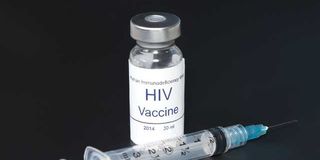Fight against HIV receives boost with Sh7bn funding

The search for a HIV vaccine has received a major boost after the government secured Sh7 billion funding.
What you need to know:
- The scientists will draw on lessons learned from the previous seven attempts to develop a HIV vaccine.
In 1996, 10.5 per cent of Kenyans were living with HIV, but since then prevalence had almost halved to 5.9 per cent in 2015.
In 2015, some 660,000 children were recorded as Aids orphans.
The search for a HIV vaccine has received a major boost after the government secured Sh7 billion in funding.
The five-year USAid funding, channelled through the Kenya Medical Research Institute (Kemri), will enable scientists from African countries develop a viable vaccine candidate at Kemri’s Kericho laboratory and advance them towards clinical trials.
According to Kemri Director-General Elijah Songok, the project will focus on existing capacity, scientific expertise and investment in community engagement in sub-Saharan Africa.
"As part of the consortium, Kenyan scientists will join forces with their colleagues from Mozambique, Nigeria, South Africa, Tanzania, Uganda, Zambia and Zimbabwe," said Prof Songok.
The scientists will draw on lessons learned from the previous seven attempts to develop a HIV vaccine.
Desired results
The Kemri Kericho laboratory, in partnership with the Walter Reed Project, has been on a journey to develop a HIV vaccine for the past 24 years.
Kemri Kericho Director Fredrick Sawe noted that the seven previous attempts had not produced the desired results.
"However, in the process of developing the seventh vaccine, we discovered that a group of people developed protection, although it was a small number," said Dr Sawe.
He added: "We are trying to find out how everyone can respond to the vaccine in the same way. That is why this funding is specifically to get the results we want.”
Dr Sawe said Kericho, being a tea plantation zone, has attracted workers and migrants from different places, hence there are close to four different HIV variants in the county.
"With a migrant population, HIV transmission is very high. If the rest of the world is dealing with one type of HIV variant, Kericho has three variants namely HIV A, C and D," he said.
He added that, if the global fight against HIV is to be successful, Kericho would have to play a major role.
The first case of HIV in Kenya was detected in 1984.
By the mid-1990s, it was one of the leading causes of illness in the country, putting a huge strain on the health system and the economy.
In 1996, 10.5 per cent of Kenyans were living with HIV, but since then prevalence had almost halved to 5.9 per cent in 2015.
This progress was largely due to the rapid scaling up of HIV treatment and care.
In 2016, some 64 per cent of people living with HIV were on treatment, of whom 51 per cent were virally suppressed.
Kenya's HIV epidemic is mainly driven by sexual transmission and is generalised, affecting all segments of the population, including children, adolescents, adults, women and men.
In 2015, some 660,000 children were recorded as Aids orphans.
However, a disproportionate number of new infections are among key populations.





